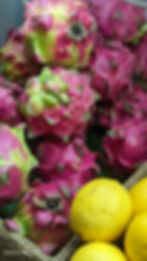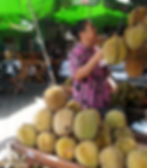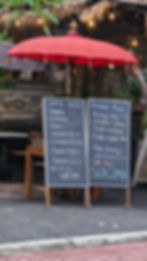Savouring the Flavours of Ubud: Affordable Eats and Local Delights
- Lyn (aka Jazz)
- May 1, 2023
- 9 min read
Updated: May 3, 2023
I should start off by saying I don't eat a lot but I do like to eat well and Bali has been an absolute culinary delight! Ubud is a foodie paradise with options for every kind of cuisine, portion size and budget. It has earned its reputation as a destination not only for fun and culture but also for great food. From street food stalls to warungs, restaurants, traditional markets and cooking classes, I have no doubt that you will find many things to please your palate and fill your tummy while sticking to your budget. Whether you are vegan, vegetarian, or a carnivore there really is something for everyone. As a budget traveller, I'm going to focus on affordable casual dining, so come meander with me and I'll share the foods and some of the places that tickled my taste buds in the Ubud area.

Mie goreng (Fried noodles) with shrimp and chicken
Where to Eat on a Budget
Street food is common with impromptu barbecues and small stalls at ridiculously low cost on every street. As twilight falls, the barbeques are lit and delicious aromas fill the air. Look for stalls selling dishes like nasi campur (steamed rice with a variety of meats, and vegetables, sate (grilled skewers), bakso (meatball soup), and jagung bakar (grilled corn with chili butter). Look for clean stalls and vendors and that attract the locals to ensure good flavours and hygiene standards. A heaping serving often costs between $3 -5 CAD. Vegan and vegetarian dishes are widely available.
Sweet snacks are also available from street vendors. Dadar gulungi, is a rolled sweet crepe filled with grated coconut and palm sugar. Klepon are small sticky rice dough balls filled with liquid palm sugar and rolled in grated coconut that are boiled and served warm.

Klepon
Tasty vegetarian offerings include tempeh, a fermented soy bean crumble, often served with peanut sauce. Gado-gado is a salad made with blanched vegetables like cabbage, green beans, bean sprouts with tofu and boiled egg, all topped with a rich peanut sauce. For those who don't eat egg, you can always ask for it without (tidak telur).

Tempeh
A favourite lunch I enjoyed was when my driver suggested picking up some Baba Guling (suckling pig) from his favourite stall to take with us to eat on our visit to Goa Raja waterfall. After playing under the waterfalls and swimming, we sat beside the river and, in true Balinese style, scooped up all that goodness using our fingers. These places often run out of the crispy skin early, so plan on arriving shortly after they open (typically around 11:00 am). Choose between Balinese spicy hot or the more mild version without the extra heat.

Babi Guling "tourist spicy" version
Warungs are small, family-run restaurants. Most serve traditional Balinese food but may also offer a few Western dishes. However, I think if you are going into a warung you should eat Indonesian. The cook is usually the Ibu (mother) who will cook with all the love and care that she does for her own family. In fact, the warung kitchen is often the family kitchen, too. Menus may or may not include English translations but will usually include a photo. Bring along your device if you will need to translate.
Plenty of vegetarian options, nasi goreng (fried rice), ayam kecup (chicken in sweet chili sauce)
My favourite warung in Ubud is Mama's Warung on Jalan Tebesaya, which was just a 3-minute walk from my homestay. Not only did I get fantastic meals but the fresh fruit juices were generous and every meal came with a small fruit plate for dessert at no extra charge. I never spent more than $10 including juice for any of the meals I enjoyed there. On gathering days at the local temple, Mama's is where the community eats following their meetings and celebrations.

Mama's on temple day
I've also enjoyed a couple of restorans, typical restaurants that serve a variety of food. I really liked the White Orchid, across from Ubud Palace. It has a fairly extensive menu of Asian food. The staff are welcoming, the prices are reasonable, and I enjoyed sitting and people-watching from the seats facing Jalan Raya. My personal favourite item was the pork and prawn dimsum, served with both a delicious sweet chili soy sauce and a mild sambal sauce.

The local markets are also great places to find traditional Balinese dishes at affordable prices. The Ubud or Sayan Night Market is a hot spot for locals. You'll see few tourists visiting but it is full of humble stalls selling incredible and cheap eats. Treat yourself to a meal of Baba Guling or a variety of gorengang (fritters with different fillings). You can also find stalls selling nasi goreng (fried rice), and mie goreng (fried noodles). Indonesian food tends to be quite spicy, so if you don't want a burning mouth make sure you let them know you want it mild or for a medium heat. Just ask for "tourist spicy".

Gorengang
No matter how much you love the local food, sometimes you might crave something more familiar. You'll easily find restaurants selling food from every nation for those occasions: Greek, Italian, Indian, Korean, Mexican, Japanese, Chinese, and Turkish, amongst many others.

Nostimo on Jl. Petitenyet, near the Sacred Monkey Forest serves a great chicken souvlaki
My favourite burger joint is Locavore To Go where, over a couple of visits, I had the Burger A la Ray (a wagyu beef burger), the loaded fries, and a really good charcuterie platter. There is a different special every night. A unique option is to go to their butcher shop next door and pick out your own steak which will be prepared as you request. Locavore To Go is located on Jalan Dewista in central Ubud.

Burger a la Ray at Locavore To Go
Fruit
When in Bali, you must check out the amazing fruits in the fruit stands and from local street sellers. I was treated to over-flowing plates of delicious fruit for breakfast in my homestays (inns) and tried a taste of every fruit I encountered. Some of the most common include bananas, pineapple, papaya, mangoes, mangosteen, rambutan, dragon fruit, durian and snake fruit.

I was told that over 300 varieties of bananas are native to Indonesia. From the common and globally-popular Cavendish banana to the starchier plantain, each has its own unique flavour and characteristic. The sweetest and creamiest varieties are the Pisang Raja (King Banana), the Pisang Ambong (Gros Michel) and the little Pisang Mas Kirana (Lady Finger) which are used mainly in desserts and smoothies. The plantain is a cousin to the banana and is bigger, less sweet and has a thicker skin and is always cooked, usually fried and is used as an accompaniment to a meal or is caramelized for a delicious dessert.

Mangosteen
Fruits that are sweetly sour and tangy are the mangosteen, rambutan and salak (snake fruit). Other than the fact that mangosteens have the word "mango" embedded in its name, they are nothing like a mango. They have a thick purple outer shell and are sweet and fairly tangy. Another fruit in this category is the rambutan with a red spiky outer shell and a soft white flesh inside. My favourite was the mangosteens, which I bought by the bag.

Salak or snake fruit
Also very popular is the durian, known as "stinky" fruit. It is large and spiky with a strong smell and creamy texture. This is the only fruit that I really did not like but many rave about it. A great deal of my food enjoyment comes with tantalizing smells and the smell of durian cannot be described as tantalizing, not even by those who love it. There are several different varieties that offer slightly different favourite taste profiles, so you might want to try them all.

Traditional Balinese drinks
I found it really interesting to discover that traditional drinks are not only for delicious hydration but they are also important in religious ceremonies and social gatherings. Brem is a sweet rice used in Hindu rituals and is used in offerings. Arak is a distilled liquor made from palm wine. It is also used in religious ceremonies and is believed to have purifying qualities.

Brem: sweet rice wine
Guests are always offered something to drink as a sign of hospitality. Most popular is kopi Bali (Balinese coffee), es keapa muda (young coconut water) and jus alpukat (avocado juice). While visiting Penglipuran village, I also sampled cem-cem, a refreshing green drink made of leaves and coconut water. Sharing a drink is seen as a sign of respect and friendship.

The Balinese also believe that many beverages include multiple health benefits. When visiting a kopi luwat (civet coffee) plantation where I sampled 12 different coffees, teas, and cocoas, each was listed as having health benefits ranging from curing head-aches and digestive issues to relieving more serious health issues. Young coconut water is believed to be the best way to cure dehydration.

Other popular traditional drinks in Ubud include es kelapa muda (young coconut water), and jamu (a traditional herbal drink). Es kelapa muda is a refreshing drink made with young coconut water and often served with ice. Jamu is a traditional herbal drink made with a blend of spices and herbs, and is believed to have health benefits.

Also very popular, although less traditional, are fresh juices and smoothies. The combination of juices and flavours seemed to be endless. My personal favourites were the pineapple-lemon juice and the strawberry yogurt blend smoothies.
Strawberry-Mango smoothie, Lemon & Pineapple juice, Mama's menu
Coffee Culture in Ubud
Ubud also has a thriving coffee culture with wide range of coffee shops and cafes offering many different types of coffee made from locally-grown coffee beans. Coffee is made by pouring hot water directly on the grounds without a filter, so the bottom part of the drink is all sludge.

Espresso is very popular too and is the base for many other coffee drinks such as cappuccinos and lattes. Cold brew and es kopi is made by steeping the grounds in cold water for several hours. It is served either black or mixed with condensed milk with palm syrup on the side. Es kopi was my go-to drink most afternoons and I enjoyed every one that I ordered in a different location every day.

Coffee shops are plentiful in Ubud, with several on each block. You could spend your entire trip just visiting coffee shops. There is even a Starbucks next to Sarasawati Temple on Jalan Raya for those who need their Starbucks fix. I am not a huge fan of Starbucks so I didn't go in.
Take a Cooking Class
A highlight for me was the Balinese cooking class that I took with Bali Wonderful Activities called the Subak Cooking Class which included pick up and return to my home-stay in Ubud. I travelled with a couple from Vietnam and met up with a group from Singapore to enjoy a full morning of visiting a market to pick up the ingredients and moving on to the cooking school where we learned how to create 7 main courses, 2 sauces, and a dessert.

Look at all the food we made!
I was especially impressed with how my allergies to coconut and egg were handled, with suggestions on alternate ingredients and keeping my dishes completely separated from the others. Although we were all meat-eaters, they were also able to create vegan and vegetarian versions.

Cooking classes are great opportunities to meet and chat with other travellers and share a meal. Not only do you learn how to prepare these special meals for friends and family at home but they are also a fabulous way to stretch the budget. For less than $30 CAD, there was more food than any of us could manage to eat and we were all offered the leftovers to take back with us saving us the cost of another meal. Cooking using the ingredients, tools, and techniques allows a deeper understanding of the culture and customs and I highly recommend the experience.

.... And the Junk Food Snacks
If you are like me, you like to head to a supermarket or convenience store to check out the junk food snacks available in a new destination. I always find it fascinating to see the differences between the junk food available at home and junk food overseas. Although I rarely eat junk food at home, when I'm travelling it's part of my experience.
Bali has the usual crisps, crackers, popcorn, candy bars, and nuts but adds its own unique touches. Crisps are available in many different flavours including many spicy and some sweet. There is an abundance of choices including roasted chicken, shrimp, salmon teriyaki and seaweed. The crisps can be made from potatoes, corn, cassava, or taro.

Bali grows cacao so it's no surprise that the chocolate is delicious. Even the inexpensive stuff from a convenience store is good, but head into the Bali Buda shop connected to the Bali Buda health food restaurant on Jalan Raya for a wide selection of cakes, cookies, and bars. Whether you enjoy dark or milk chocolate, you are sure to find a flavour to entice you. The chocolate brownie from the bakery is especially good with a cup of Bali coffee.

A popular flavour for crackers is keju manis (sweet cheese). This doesn't taste anything like cheese. It's more of a sweet custardy taste that I quite enjoyed.

The food and drink in Bali is tasty, plentiful, and very affordable. Budget traveller will be able to find a plethora of choices to suit every taste and budget. You will not go hungry or break the bank. With many choices on every block, you are sure to find your favourites. Your biggest difficulty will be making a choice!
Thanks for meandering with me! Let me know your thoughts or add some information I missed in the comments below. Help the blog grow and remain ad-free by sharing the link with a travelling friend or on your social media. Become a member/subscriber (for free!) to get notified of new content and get access to our FB discussion group for female travellers. *Note to fellow bloggers... you need to subscribe and be logged in for your comments to show your name. Send me a messsage and I'll add your website to your name.



























